mardi 15 septembre 2015
Riding a Honda C90 motorcycle through the Arctic Circle in Winter
Riding a Honda C90 motorcycle through the Arctic Circle in Winter (music video) *headphones recommended* from c90 adventures on Vimeo.
I was alone with only my trusty c90, a camera and camping equipment. The coldest temperature I recorded was -23oC inside my tent.
Visit my website: c90adventures.co.uk for more videos and info on this and my other trips me and little c90 have done together.
I also sell t-shirts through dirtpunk.co.uk who sponsored me my Arctic sleeping bag and as such are the reason I'm still alive :)
Top Five Favorite Four Wheeler Projects - Cinco De Besto
Photographers: Four Wheeler Archives
Since Four Wheeler’s first issue way back in 1962, dozens and dozens of official magazine project vehicles have graced its pages. Some were groundbreaking, some were forgettable, some were timeless, and some were embarrassingly bad. But only a select few can be considered the best. Editor-in-Chief Hazel and Art Director Smith flipped through each and every issue of Four Wheeler ever printed to identify, select, and rate ‘em into one list of the good, the bad, and the noteworthy. So let’s start it off with the best five Four Wheeler project rigs of all time.
Project IFS No More
Definitely one of the coolest vehicles to grace the pages of Four Wheeler, Ned Bacon’s 1-ton axle upgrade for his 1989 1⁄2-ton was heady stuff in its day. Already equipped with serious off-road upgrades to support Ned’s backcountry wanderlust like a custom utility/camping bed, auxiliary fuel tank, onboard welder, Warn 8274 winch, onboard air, an NV4500 five-speed tranny swap, and a Ranger Underdrive gearbox, the GM lost its IFS front suspension for some simple and affordable leaf springs.
The front used 52-inch-long, 8-inch-lift Skyjacker packs designed for the rear of a 1969-1987 GM truck. Out back, Ned used Skyjacker 63-inch-long, 51⁄2-inch-lift packs. Rancho RS9000s -- four in front and two in rear -- damped the movement of the 1979 Ford F-350 Dana 60 front and 14-bolt rear. Ned used an ARB in the front and Detroit Locker in the back, while 4.56 gears helped the 205,000-mile TBI 350 spin the 36-inch tires on heavy steel wheels.
Project Tug Boat
The somewhat hokey project name aside, Greg Whale’s multi-part buildup series of the 1992 Cummins-powered Dodge W250 was one of the first times any magazine highlighted the massive potential of the mighty 5.9L Cummins engine in a Dodge pickup. Although many installments dealt with common off-roading elements like 33x12.50R16.5 BFG A-T tires and custom National Spring leaf packs, eventually they got to the meat of the matter: turning the screws on the 5.9L. With some easy mods, such as a new intercooler and a high-flow muffler and air filter, the Tug Boat saw a roughly 50 lb-ft improvement at the rear tires.
A subsequent follow-up netted the project a new turbo and some other select parts from Banks (as well as some fueling mods we imagine) that allowed the Cummins to spin the dyno rollers to the tune of 235 hp and 643 lb-ft at the tires. That’s plenty of torque to frag the axleshafts of the Dana 60 front and Dana 70 rear, if the tires could ever get enough grip. Nowadays, those are the factory torque numbers of any 3⁄4- or 1-ton pickup, but back then, 400 lb-ft was mind-blowing. And anything over 600 lb-ft was just unreal.
The Baja 1000 FJ40
Back in 1974, Four Wheeler decided to take its propane-powered Clean Air Land Cruiser project to race the Baja 1000. Just hoping to cross the line under its own power and maybe secure a modest Eighth or Ninth Place, the FJ40 wound up winning its class (Class 3, Four-Wheel-Drive Stock Production) with only minor modifications from stock.
Piloted by Bill Sanders and Pete Springer and wearing Number 169, it was converted back to run on gasoline and then loaded with such hardcore off-road fare as six rear and four front Gabriel shocks, heavy-duty springs, Dick Cepek Tru-Trac tires on Superior wheels, a Smittybilt rollbar, a 35-gallon foam-filled fuel cell, and a Man-A-Fre fiberglass hood. Ultimately, the little Toyota served for more exotic articles like a turbo install, but in its day, it showed what could be done with a basically stock vehicle and a handful of bolt-on modifications, as long as you had a dedicated support crew and some hardcore drivers.Back in 1974, Four Wheeler decided to take its propane-powered Clean Air Land Cruiser project to race the Baja 1000. Just hoping to cross the line under its own power and maybe secure a modest Eighth or Ninth Place, the FJ40 wound up winning its class (Class 3, Four-Wheel-Drive Stock Production) with only minor modifications from stock.
Project IFS No More
Definitely one of the coolest vehicles to grace the pages of Four Wheeler, Ned Bacon’s 1-ton axle upgrade for his 1989 1⁄2-ton was heady stuff in its day. Already equipped with serious off-road upgrades to support Ned’s backcountry wanderlust like a custom utility/camping bed, auxiliary fuel tank, onboard welder, Warn 8274 winch, onboard air, an NV4500 five-speed tranny swap, and a Ranger Underdrive gearbox, the GM lost its IFS front suspension for some simple and affordable leaf springs.
The front used 52-inch-long, 8-inch-lift Skyjacker packs designed for the rear of a 1969-1987 GM truck. Out back, Ned used Skyjacker 63-inch-long, 51⁄2-inch-lift packs. Rancho RS9000s -- four in front and two in rear -- damped the movement of the 1979 Ford F-350 Dana 60 front and 14-bolt rear. Ned used an ARB in the front and Detroit Locker in the back, while 4.56 gears helped the 205,000-mile TBI 350 spin the 36-inch tires on heavy steel wheels.
PhotosView Slideshow
Project Solid Swap
Running alongside Ned Bacon’s low-buck conversion in the same issues in 1997 was Ben Stewart’s higher-zoot, higher-dollar IFS delete on his GM truck. For the time, it was a pretty exotic setup capable of delivering performance that could far outpace the driving ability of most novice off-roaders -- or experienced magazine editors, as Ben found out on his shakedown run. Intoxicated with the 1990 1500’s new capability, Ben stuffed the front end straight into a three-foot-tall wall of a dry wash, bending the panhard bar and damaging numerous other components in the process.
Regardless of the operator error, the truck was a beacon of cutting-edge tech for its day. Where Ned used cheap and inexpensive leaf springs, Ben went for swoopy 60-series Bilstein remote-reservoir coilovers and a custom four-link up front, with long-travel National Spring race packs and a quartet of Bilsteins in the rear. The 1979 Ford Dana 44 front axle was completely retubed with 0.500-wall DOM material and stuffed with an ARB and 4.56s at Dirt Trix, the Phoenix-based shop that did the buildup. Out back, a 35-spline semi-float Dynatrac 60 rear with 4.56s and an ARB eschewed other heavyweight options. Even the 35x12.50R15 Big O M/T tires were (for its day) large and high-tech. It’s a buildup that would still catch a second look in the dunes.Running alongside Ned Bacon’s low-buck conversion in the same issues in 1997 was Ben Stewart’s higher-zoot, higher-dollar IFS delete on his GM truck. For the time, it was a pretty exotic setup capable of delivering performance that could far outpace the driving ability of most novice off-roaders -- or experienced magazine editors, as Ben found out on his shakedown run. Intoxicated with the 1990 1500’s new capability, Ben stuffed the front end straight into a three-foot-tall wall of a dry wash, bending the panhard bar and damaging numerous other components in the process.
PhotosView Slideshow
Project Teal-J
Project Teal-J kind of makes both the best and worst list, but we’ll be nice and focus on the first buildup series from 1997 done by Ben Stewart. When the 1997 TJ hit the showroom floors in 1996, it was welcomed with open arms by the off-road community, unlike the YJ which preceded it. One of the first magazine TJ projects, Teal-J highlighted just how capable these little monsters could be with only a handful of carefully selected parts. Upgrades like a 4:1 T-case for the NP231, a TeraFlex slinky-coil suspension, drop-in lockers and 4.10 gears, and even 15x10 Stockton beadlocks all seem commonplace nowadays. However, back then, they were cutting edge and helped make hardcore parts mainstream, if not mundane.
The second buildup series in 2003-04 saw further upgrades, but not always for the better. And by the time the third iteration of this vehicle’s life came around, it was rife with compromises. Some project rigs are like a painting: You need to know when to put down the brush. But in its early stages, Teal-J was a showcase of the best parts of its day that served equally well on the street or the trail and that could be replicated by virtually any off-road enthusiast.Project Teal-J kind of makes both the best and worst list, but we’ll be nice and focus on the first buildup series from 1997 done by Ben Stewart. When the 1997 TJ hit the showroom floors in 1996, it was welcomed with open arms by the off-road community, unlike the YJ which preceded it. One of the first magazine TJ projects, Teal-J highlighted just how capable these little monsters could be with only a handful of carefully selected parts. Upgrades like a 4:1 T-case for the NP231, a TeraFlex slinky-coil suspension, drop-in lockers and 4.10 gears, and even 15x10 Stockton beadlocks all seem commonplace nowadays. However, back then, they were cutting edge and helped make hardcore parts mainstream, if not mundane.
Project Tug Boat
The somewhat hokey project name aside, Greg Whale’s multi-part buildup series of the 1992 Cummins-powered Dodge W250 was one of the first times any magazine highlighted the massive potential of the mighty 5.9L Cummins engine in a Dodge pickup. Although many installments dealt with common off-roading elements like 33x12.50R16.5 BFG A-T tires and custom National Spring leaf packs, eventually they got to the meat of the matter: turning the screws on the 5.9L. With some easy mods, such as a new intercooler and a high-flow muffler and air filter, the Tug Boat saw a roughly 50 lb-ft improvement at the rear tires.
A subsequent follow-up netted the project a new turbo and some other select parts from Banks (as well as some fueling mods we imagine) that allowed the Cummins to spin the dyno rollers to the tune of 235 hp and 643 lb-ft at the tires. That’s plenty of torque to frag the axleshafts of the Dana 60 front and Dana 70 rear, if the tires could ever get enough grip. Nowadays, those are the factory torque numbers of any 3⁄4- or 1-ton pickup, but back then, 400 lb-ft was mind-blowing. And anything over 600 lb-ft was just unreal.
From: http://www.fourwheeler.com
Mo Faraz’s ‘Car-Toons’ show a humorous journey through time

Although graphic design artist Mo Faraz uses the latest technology to create his illustrations, his humorous works appear to come straight from a bygone era…
Nostalgic amusement
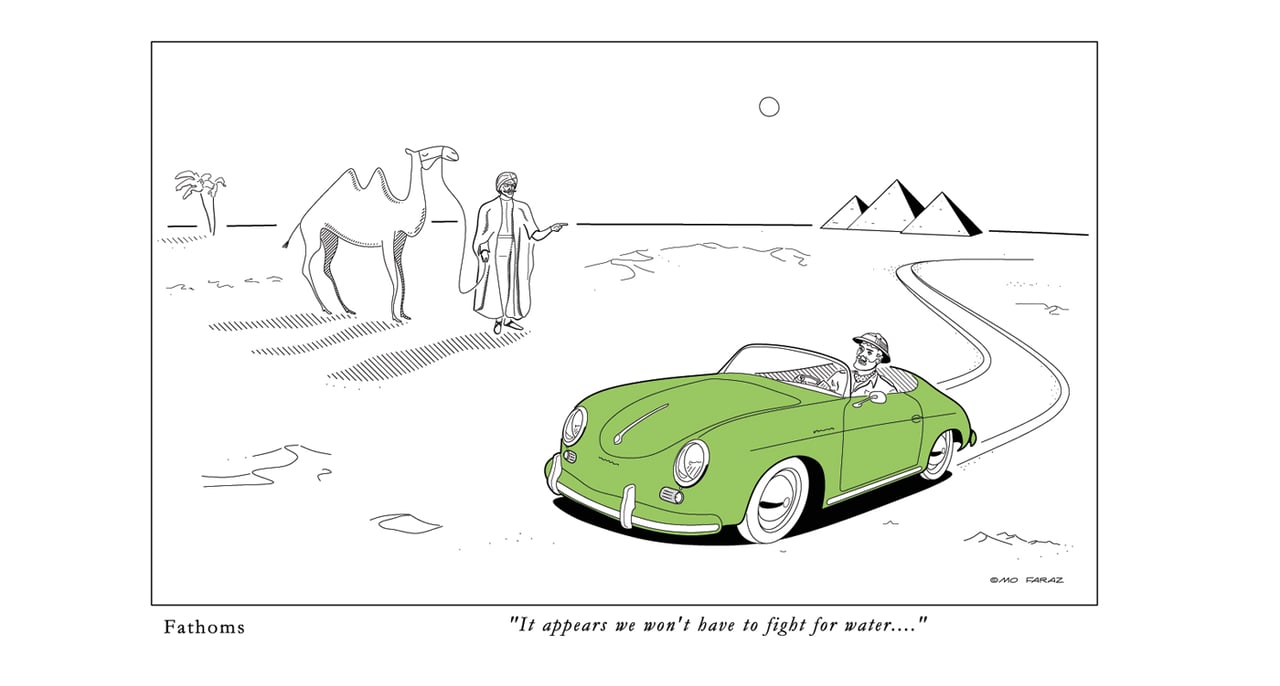
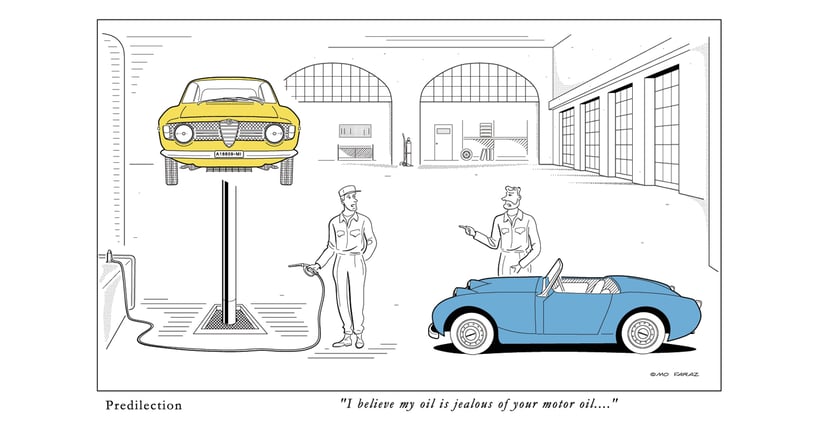
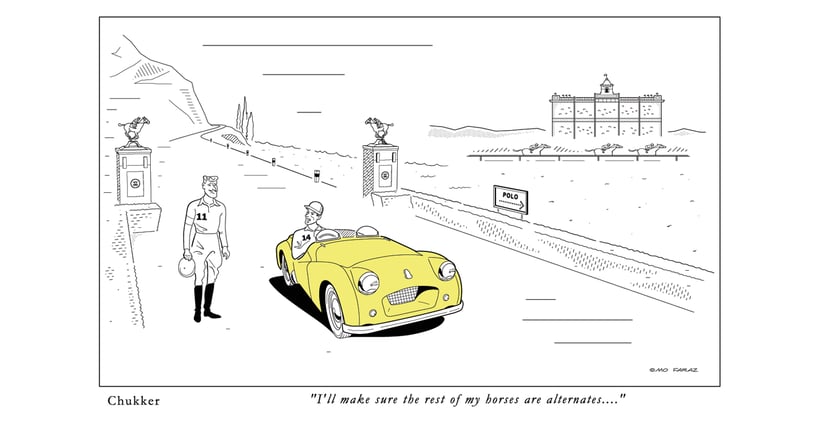
Comedy is an art itself, but Mo Faraz has managed to combine two forms in his latest illustration series, placing classic cars and their owners in a variety of comical situations. He visualises the odd scenarios in which classic car owners might find themselves and adds a subtle dose of satire, fuelled by his own experiences of ownership (he had his first classic Alfa Romeo at age 15). The simple yet beautiful silkscreen prints can now be bought through his website.

The policeman’s De Tomaso Pantera from ‘Hawaii Five-0’

As an early ‘push-button’ Pantera, this De Tomaso is a rarity in its own right. But a stint as a ‘Hawaii Five-0’ car, both on and off screen, gives it a unique and even more intriguing history…

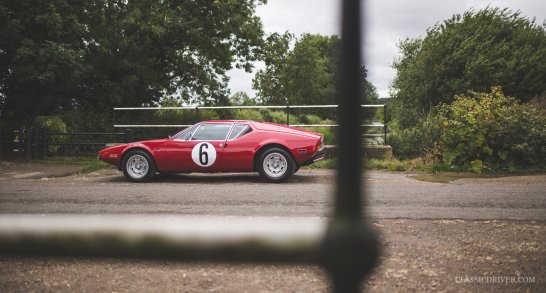
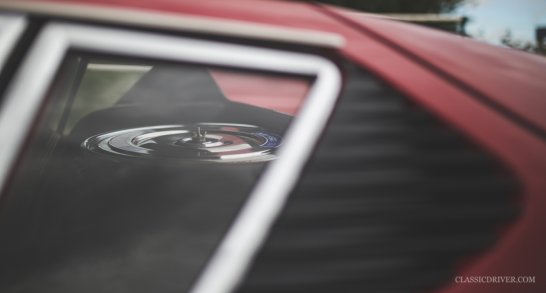
One of the primary lures of the De Tomaso Pantera is its mix of brawny American V8 and taut, purposeful bodywork of the type that had become popular with Italian coachbuilders (in this case, Ghia) in the early 1970s. However, this Pantera has a continent-crossing story of its very own: it spent much of its life in Hawaii – where it was owned by a policeman and used in the famous TV series ‘Hawaii Five-0’ – before recently becoming part of a UK-based collection. We took it on a short outing through unfamiliar territory: the damp roads of northern England, to be specific.
Setting the Pulsante racing...

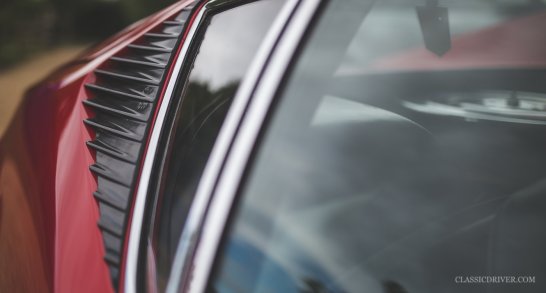
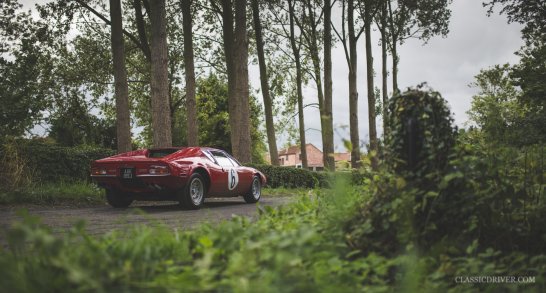
The Pantera in question is a rare, early Pantera ‘Pulsante’, so named because it was one of the ‘first execution’ cars that retained the push-button door catches of previous models. Although these were true to the original designs penned by Ghia’s American stylist Tom Tjaarda, they were actually hand-built by Vignale prior to a full production run with America in mind.
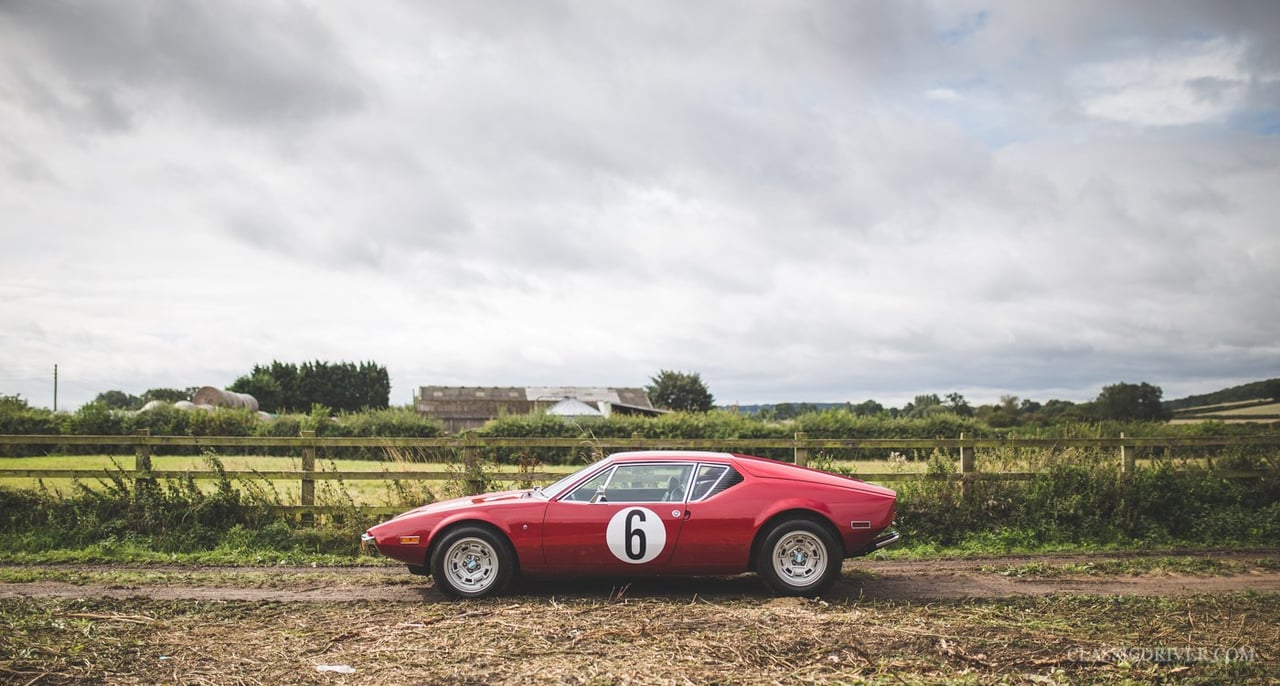
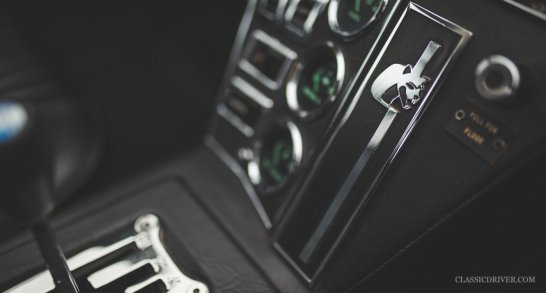

At the time, ‘Hawaii Five-0’ was the most-watched television series in the world. Soon after the car was delivered to its policeman owner, the show’s producers required a pair of Panteras for a storyline in the fifth-season episode, ‘Death Wish on Tantalus Mountain’. Ford, which usually supplied vehicles for the show and was listed in the credits, was not able to provide a demonstrator, as the car was in short supply. Instead, a search began to find existing Pantera owners in Hawaii. Two cars were found, one yellow and one red – the custodian of the latter being a Hawaiian policeman by the name of George Frain. When actor Ricardo Montalbano (who played the part of Alex Pareno, a wealthy motor racing enthusiast) was injured before the filming took place, Frain stepped in and drove the car himself.
The crimson Panther
In the story, gentleman racer Alex Pareno’s mechanic is slain on the eve of a high-profile hillclimb in Hawaii. The episode includes several driving sequences in which the Pantera is rapidly hustled along the dirt roads leading up the Tantalus Mountain, with its real-life owner, policeman George Frain at the wheel. There is one dynamic shot that looks down over the roof and chiselled bonnet while the car is in motion – a shot achieved by removing the engine cover and strapping the cameraman into a makeshift chair above the engine. However, as dramatic as its 15 minutes of on-screen fame was, one does wonder whether the car's off-screen life was even more eventful, as Frain kept the car for 35 years, before selling it on to... another Hawaiian policeman, in 2006.
From Hawaii to... Nottingham
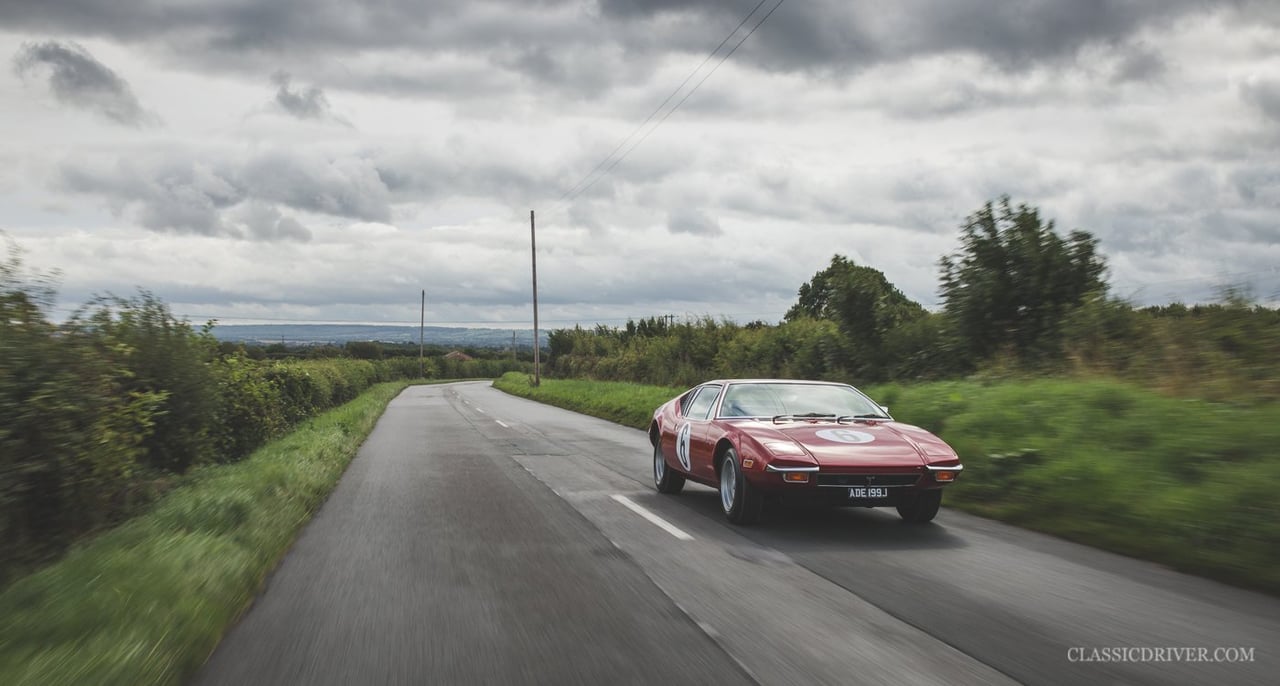
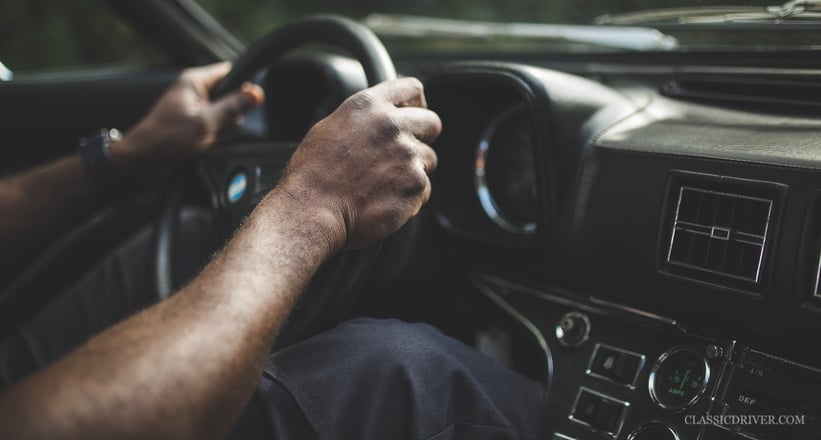
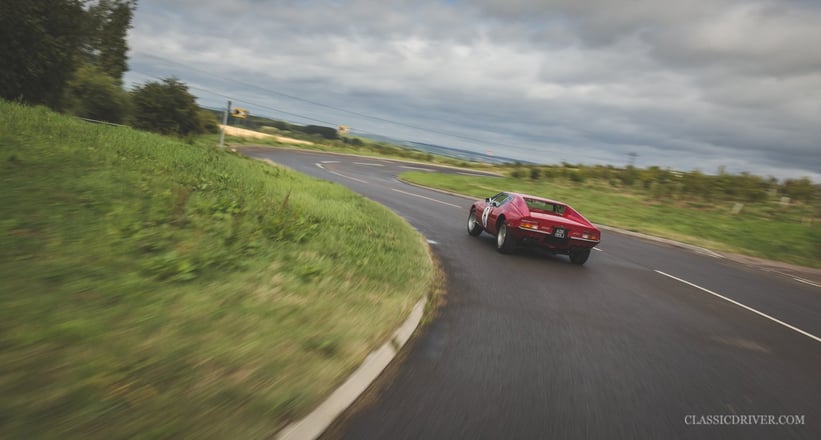
While the large-audience, small-screen appearance might have seen the Pantera flung around the mountain tracks quite enthusiastically, the brief for today’s journey is more sedate – and after watching the episode, that’s something for which we’re quite grateful. Instead, we happily take the time to acquaint ourselves with the ‘crimson Panther’ properly: it affords us the opportunity to savour the bassy thrum of the Cleveland V8 as it warms its cylinders, and feel the satisfaction of guiding the gear lever through the dogleg chrome gate, down into first. On the move, the soundtrack progresses from a thrum, into a howl through the mid-ranges, and up to a full-blown wail near the red line. In period, Alessandro de Tomaso said that most owners would rather hear the Pantera’s 351ci V8 than Janis Joplin – we’re not sure if that still applies today, but the point remains. And if the spirited driving sequences in the show weren’t enough to remind you of the Pantera’s performance potential, the steeply raked windscreen, compact steering wheel and reassuringly firm ride do so soon enough.
Plenty of stories
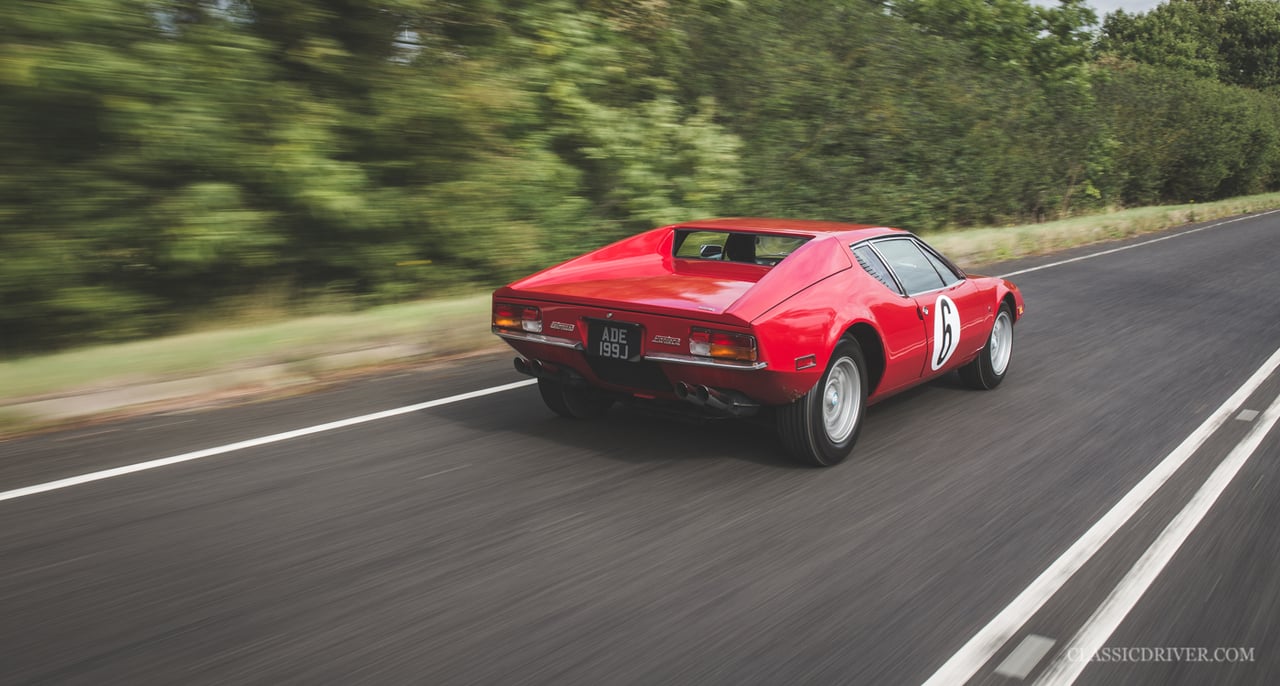
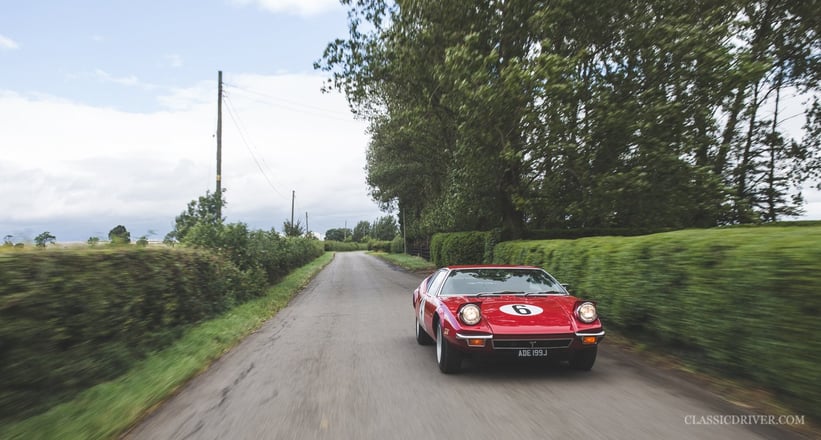

Fresh from restoration, albeit retaining its original configuration and the #6 livery it wore on-screen, this 1971 De Tomaso Pantera is now just as desirable as the day it was delivered new to Hawaii – but with the addition of an abundance of ‘stories’, both told and untold, that increase its curiosity value. It will cross the block this coming Friday at Silverstone Auctions’ 2015 Salon Privé sale; if you’re there, do stop by to say ‘Aloha’…
Photos: Tom Shaxson for Classic Driver © 2015
There are numerous classic De Tomasos for sale in the Classic Driver Market.
Who'd play Enzo Ferrari best – Christian Bale or Robert De Niro?

Not one, but two Hollywood greats will soon portray Enzo Ferrari on screen. Robert De Niro and Christian Bale will both become ‘Il Commendatore’, in two unrelated movie productions...
The two Enzos


In April, Classic Driver reported that Robert De Niro will take on the lead role in a biopic about the life of Enzo Ferrari. The movie is to be based on Ferrari’s self-published autobiography ‘Ferrari 80’, and will document the career of the legendary company founder and racing manager, from the 1940s through to the 1980s. Rumour has it that director of ‘American Sniper’, Clint Eastwood, will be behind the camera. However, another major studio is also working on a movie drama about the notoriously moody Ferrari chief. This time, ‘Il Commendatore’ will apparently be played by former ‘Batman’ Christian Bale, with Michael Mann (of ‘Heat’ and ‘Miami Vice’ fame) given the directorial reins. However, the latter is not based on Ferrari’s entire career, instead focusing on the dramatic events of the year 1957, when the Scuderia chief had to cope with the deaths of drivers Alfonso de Portago and Edmund Nelson, along with nine spectators at the Mille Miglia, as described in the book ‘Enzo Ferrari: The Man, The Cars, The Races’ penned by the American writer Brock Yates.
This Hollywood showdown looks to have the makings of an epic duel – just how Old Man Ferrari would have wanted it.
Photos: Getty Images / Rex Features
Fun Cup Castellet : Caprasse, Bollen, Debrus et le Team Allure ont maté les Français
S'il est compliqué d'obtenir le classement d'une course de la Fun Cup française peu après l'arrivée, on peut néanmoins vous annoncer que l'épreuve disputée sur le circuit Paul Ricard ce dimanche s'est achevée sur une victoire... belge ! Réunis au volant de la #277 du Team Allure de Jean-François Olivier, Fred Caprasse, Cédric Bollen et Gilles Debrus ont en effet été les meilleurs, s'imposant devant la #261 Defi-8 et la #275 Zosh. Le succès du Team Allure est complété par la 6ème place de la #274, confiée à Pierre Piron, Gilles Piron, Philippe Soussan et Jean-François Olivier, tandis que la #278 Acome Racing a clôturé la course au 7ème rang. Moins de chance pour la #279 de Geoffroy Horion et Lionel Vandercam, qui avait signé un excellent 3ème temps aux qualifs avant que Horion ne soit percuté par un autre Belge, Christophe Nivarlet. En attendant, une petite Brabançonne au pays des cigales... (Vincent Franssen)
Inscription à :
Articles (Atom)





